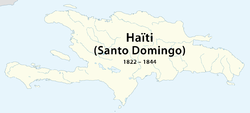Republic of Haiti République d'Haïti (French) | |||||||||
|---|---|---|---|---|---|---|---|---|---|
| 1822–1844 | |||||||||
 Map of Hispaniola from 1822 to 1844 | |||||||||
| Status | Annexed to Haiti | ||||||||
| Capital | Santo Domingo | ||||||||
| Common languages | French (official) Spanish | ||||||||
| Demonym(s) | Haitian[a] | ||||||||
| Government | Military occupation | ||||||||
| President | |||||||||
• 1822–1843 (first) | Jean-Pierre Boyer | ||||||||
• 1843–1844 (last) | Charles Rivière-Hérard | ||||||||
| History | |||||||||
• Established | February 9, 1822 | ||||||||
• Dominican Declaration of Independence | January 16, 1844 | ||||||||
• Dominican War of Independence (end of occupation) | February 27, 1844 | ||||||||
| Currency | Gourde (HTG) | ||||||||
| ISO 3166 code | HT | ||||||||
| |||||||||
| Today part of | Dominican Republic | ||||||||
The Haitian occupation of Santo Domingo[b] (Spanish: Ocupación haitiana de Santo Domingo; French: Occupation haïtienne de Saint-Domingue; Haitian Creole: Okipasyon ayisyen nan Sen Domeng) was the annexation and merger of then-independent Republic of Spanish Haiti (formerly Santo Domingo) into the Republic of Haiti, that lasted twenty-two years, from February 9, 1822, to February 27, 1844.[3][4] The part of Hispaniola under Spanish administration was first ceded to France and merged with the French colony of Saint Domingue as a result of the Peace of Basel in 1795. However, with the outbreak of the Haitian Revolution the French lost the western part of the island, while remaining in control of the eastern part of the island until the Spanish recaptured Santo Domingo in 1809.[5]
Santo Domingo was regionally divided with many rival and competing provincial leaders. During this period, the Spanish crown had limited influence in the colony. Dominican military leaders had become rulers, where the "law of machete" governed the land. On November 9, 1821, the former captain general in charge of the colony, José Núñez de Cáceres, decided to overthrow the Spanish government and declared independence from Spain. Meanwhile the mulatto president of Haiti, Jean-Pierre Boyer, offered his support to the frontier governors, and thus they allowed him to enter the city of Santo Domingo with around 10,000 soldiers in February 1822 which lead to the occupation.
After losing the support of the elites, the Haitian president Boyer was ousted in 1843, with Charles Rivière-Hérard replacing him as president.[6] Nationalist Dominican forces in eastern Hispaniola led by Juan Pablo Duarte seized control of Santo Domingo on 27 February 1844.[6] The Haitian forces, unprepared for a significant uprising, surrendered to the Dominican rebels, effectively ending Haitian rule of eastern Hispaniola. In March Rivière-Hérard attempted to reimpose his authority, but the Dominicans inflicted heavy losses.[7] Rivière-Hérard was removed from office by the mulatto hierarchy on May 3, 1844.
In the Dominican Republic Independence Day is celebrated on February 27, the day of revolt against Haitian occupation.[8]
Cite error: There are <ref group=lower-alpha> tags or {{efn}} templates on this page, but the references will not show without a {{reflist|group=lower-alpha}} template or {{notelist}} template (see the help page).
- ^ "Dominican Republic – The first colony". Country Studies. Library of Congress; Federal Research Division. Retrieved June 19, 2008.
- ^ Hand Book of Santo Domingo: Bulletin, Issue 52. U.S. Government Printing Office, 1892. Digitized 14 August 2012. p. 3. "...the Republic of Santo Domingo or República Dominicana (Dominican Republic) as it is officially designated."
- ^ United States Geographic Board, ed. (1890–1891). First Report of the United States – Board of Geographic Names 1890–1891. Washington Government Printing Office. p. 45. Retrieved 13 September 2015.
haiti; island.
- ^ "World Leaders Index: Dominican Republic". Archived from the original on 2015-06-20. Retrieved 2015-04-26.
- ^ Wars of the Americas: A Chronology of Armed Conflict in the New World, 1492 to the Present. David Marley, 1998. [ISBN missing] [page needed]
- ^ a b "Haiti", Encyclopædia Britannica.
- ^ Bethell, Leslie (1984). The Cambridge History of Latin America: Volume 3. Cambridge University Press. pp. 267–269.
- ^ Dominican Independence Day

